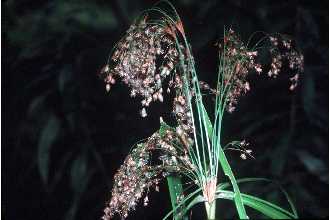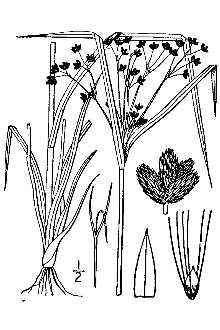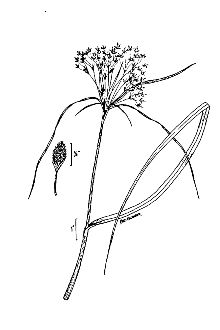Scirpus rubricosus Fernald
Scientific Name: Scirpus rubricosus Fernald

| General Information | |
|---|---|
| Usda Symbol | SCRU4 |
| Group | Monocot |
| Life Cycle | Perennial |
| Growth Habits | Graminoid |
| Native Locations | SCRU4 |
Plant Guide
Alternative Names
cotton grass bulrush, common wool-grass
Uses
Ethnobotanic: Woolgrass stems were woven to make matting and ropes. The fruiting tops of the plant were used as a resilient material for stuffing and making pillows (Moerman 1998). The small rushes were used in making woven mats and storage bags (Ibid.).
Status
Please consult the PLANTS Web site and your State Department of Natural Resources for this plant’s current status, such as, state noxious status and wetland indicator values, , Use soil moisture sensors to measure the soil moisture of Scirpus rubricosus Fernald.
Description
General: Sedge family (Cyperaceae). Woolgrass (Scirpus cyperinus) is a tall perennial with slender culms. This species is an erect grasslike plant that commonly grows four to five feet (Tiner 1987). The leaves are smooth, flat, elongated, and up to ½ inch wide. The flowers occur in dense rounded clusters of greenish-brown spiklets arising from the top of the culm. The fruits are yellow-gray to white achenes surpassed by long red-brown bristles at maturity. Distribution: Scirpus cyperinus ranges from New England and New York westward across Ohio to Iowa, and southward to North Carolina and Oklahoma. It is also found from Newfoundland to Minnesota south to Florida and Louisiana (Tiner 1987). For current distribution, please consult the Plant profile page for this species on the PLANTS Web site.
Adaptation
Woolgrass is found in irregularly flooded tidal fresh marshes, inland marshes, wet meadows, and swamps. This species grows best in areas with wet soil moisture content and is seldom found in more than a few inches of water (Voss 1972). It prefers peat or sandy soil types in full to partially sunny locations. R. Mohlenbrock USDA, NRCS, Wetlands Institute @ PLANTS
Establishment
Propagation by Seed: Scirpus cyperinus seeds should be sown in a cold frame as soon as they are ripe in a pot standing in three centimeters of water. The seeds germinate quickly. When they are large enough to handle, plant them into their permanent positions in early summer. Large divisions can be planted directly into their permanent positions. It is best to pot smaller divisions and grow them in a cold frame, out-planting when they are well established in the summer.
Management
After seed planting, water level over Scirpus cyperinus seeds should be maintained at one foot for two weeks. Periodic flooding up to three feet should occur until the seeds are established. Cultivars, Improved and Selected Materials (and area of origin) Available through wetland plant nurseries. Contact your local Natural Resources Conservation Service office for more information. Look in the phone book under ”United States Government.” The Natural Resources Conservation Service will be listed under the subheading “Department of Agriculture.”
References
Braun, L.E. 1967. The monocotyledoneae from cat-tails to orchids. The Ohio State University Press, Columbus, Ohio. Britton, N.L. & A. Brown 1970. An illustrated flora of the northern United States and Canada. Dover Publications, New York, New York. Bruggen, T. V. 1976. The vascular plants of South Dakota. The Iowa State University Press, Ames, Iowa. Gleason, H. A. & A. Cronquist 1993. Manual of vascular plants of northeastern United States and adjacent Canada. 2nd ed. The New York Botanical Garden, Bronx, New York. Moerman, D. 1998. Native American ethnobotany. Timber Press, Oregon. Radford, A.E., H.E. Ahles, & C.R. Bell 1968. Manual of the vascular flora of the Carolinas. The University of North Carolina Press, Chapel Hill, North Carolina. Straughbaugh, P. D. & E. L. Core 1977. Flora of West Virginia. 2nd ed. Seneca Books, Inc., Morgantown, West Virginia. The Great Plains Flora Association 1986. Flora of the Great Plains. University Press of Kansas, Lawrence, Kansas. Tiner, R.W. Jr. 1987. A field guide to coastal wetland plants of the northeastern United States. The University of Massachusetts Press, Amherst, Massachusetts. Voss, E.G. 1972. Michigan flora. Cranbrok Institute of Science, Bloomfield Hills, Michigan, and University of Michigan Herbarium, Ann Arbor, Michigan.
Plant Traits
Growth Requirements
| Temperature, Minimum (°F) | -33 |
|---|---|
| Adapted to Coarse Textured Soils | Yes |
| Adapted to Fine Textured Soils | Yes |
| Adapted to Medium Textured Soils | Yes |
| Anaerobic Tolerance | Medium |
| CaCO3 Tolerance | Medium |
| Cold Stratification Required | No |
| Drought Tolerance | Low |
| Fertility Requirement | Medium |
| Fire Tolerance | Medium |
| Frost Free Days, Minimum | 110 |
| Hedge Tolerance | None |
| Moisture Use | High |
| pH, Maximum | 7.2 |
| pH, Minimum | 4.8 |
| Planting Density per Acre, Maxim | 4800 |
| Planting Density per Acre, Minim | 3450 |
| Precipitation, Maximum | 60 |
| Precipitation, Minimum | 40 |
| Root Depth, Minimum (inches) | 12 |
| Salinity Tolerance | None |
| Shade Tolerance | Intermediate |
Morphology/Physiology
| After Harvest Regrowth Rate | Slow |
|---|---|
| Toxicity | None |
| Resprout Ability | No |
| Shape and Orientation | Erect |
| Active Growth Period | Spring |
| Bloat | None |
| Coppice Potential | No |
| Fall Conspicuous | No |
| Fire Resistant | No |
| Flower Color | Green |
| Flower Conspicuous | No |
| Foliage Color | Green |
| Foliage Porosity Summer | Moderate |
| Foliage Porosity Winter | Porous |
| Fruit/Seed Color | Yellow |
| Nitrogen Fixation | None |
| Low Growing Grass | No |
| Lifespan | Long |
| Leaf Retention | No |
| Known Allelopath | No |
| Height, Mature (feet) | 4.9 |
| Growth Rate | Moderate |
| Growth Form | Bunch |
| Fruit/Seed Conspicuous | Yes |
| Foliage Texture | Coarse |
Reproduction
| Vegetative Spread Rate | None |
|---|---|
| Small Grain | No |
| Seedling Vigor | Medium |
| Seed Spread Rate | Rapid |
| Fruit/Seed Period End | Fall |
| Seed per Pound | 36000000 |
| Propagated by Tubers | No |
| Propagated by Sprigs | Yes |
| Propagated by Sod | No |
| Propagated by Seed | Yes |
| Propagated by Corm | No |
| Propagated by Container | No |
| Propagated by Bulb | No |
| Propagated by Bare Root | No |
| Fruit/Seed Persistence | Yes |
| Fruit/Seed Period Begin | Summer |
| Fruit/Seed Abundance | Medium |
| Commercial Availability | Routinely Available |
| Bloom Period | Late Summer |
| Propagated by Cuttings | No |
Suitability/Use
| Veneer Product | No |
|---|---|
| Pulpwood Product | No |
| Post Product | No |
| Palatable Human | No |
| Palatable Graze Animal | Medium |
| Nursery Stock Product | No |
| Naval Store Product | No |
| Lumber Product | No |
| Fodder Product | No |
| Christmas Tree Product | No |
| Berry/Nut/Seed Product | No |


